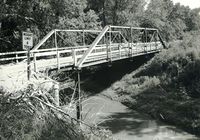NRHP: Sweetwater Mill Bridge
Contents
[hide]Sweetwater Mill Bridge
NRHP Reference #: 92000767
NRHP Listing Date: 19920629
Location
S edge of Sweetwater, Buffalo County, Nebraska
View this property's location
View all NRHP properties on this map.
Summary
In November 1908 the Buffalo County Board of Supervisors adopted bridge plans prepared by the Standard Bridge Company as the county standards. The board awarded an annual bridge construction contract to Standard two months later, purchasing numerous small-scale bridges from the Omaha-based firm throughout 1909. Among the structures ordered in May was this eighty-foot pinned pony truss over Mud Creek in Beaver Township. Located at the Sweetwater Mill near the county's northern edge, the truss replaced an earlier bridge at this location, using the existing stringer approaches on both sides of the channel span in conjunction with new H-shaped steel pile bent supports for the truss. Standard completed the bridge later in 1909, using steel components rolled by Illinois Steel Company. Although the pinned pony truss of the Sweetwater Bridge is unremarkable as a typical example of a relatively common structural type, the bridge is significant as one of the earliest and best preserved examples remaining in the state of an original Standard Bridge Company built-up H-pile substructure.
Further Information
Bibliography
About the National Register of Historic Places
The National Register of Historic Places (NRHP) is the country’s official list of historically significant properties. To be eligible for the NRHP a property must generally retain their historic appearance, be at least 50 years old, and have the potential to be documented as historically or architecturally significant at either the local, state, or national level. The National Register of Historic Places is a National Park Service program administered by the Nebraska State Historical Society for the state of Nebraska. Visit the Nebraska State Historical Society's website to learn more about the program.
